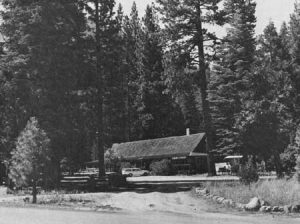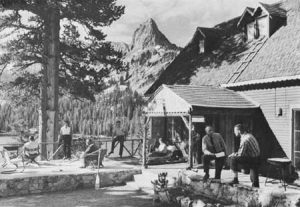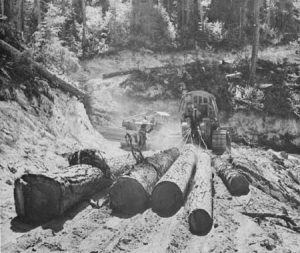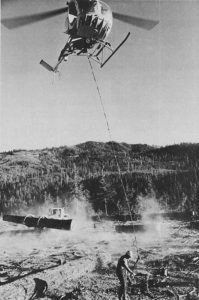AFTER WORLD WAR II 1945-1967

An international organization for forestry was started under the auspices of the United Nations Food and Agriculture Organization (FAO). At the first meeting of the FAO in 1944, a technical committee on forestry and primary forest products was set up, with nine nations represented, under the chairmanship of Henry S. Graves, dean emeritus of the Yale School of Forestry and former Chief of the Forest Service. A report of this committee called attention to the fact that"in the face of . . . rapidly multiplying uses for wood which create ever-mounting wood needs, the world is confronted by the inescapable fact that the forests—sole source of wood—are steadily diminishing."
At a meeting of the FAO in Quebec in the fall of 1945, a strongly united group representing 21 nations made up the Forestry Committee. In 1946, a Branch of Forestry and Forest Products was set up as a permanent organization under FAO, and Marcel LeLoup, formerly Director General of the Department of Forests and Waters of France, was named Director. S. B. Show, Deputy Director, came from the Forest Service. The organization undertook to set up worldwide forestry statistical services, assist governments with advice on forest policy,send out missions to make scientific studies, promote research and circulate findings among nations, and facilitate exchange of scientific personnel.
1945 The first Smokey Bear symbol appeared on a national poster to spearhead the cooperative forest fire prevention program. Smokey became one of the best known advertising symbols in the United States, as a result of the time and space donated by the media working with the Advertising Council, Inc., the National Association of State Foresters, and the Forest Service.
1946 An American Forest Congress was held in Washington, D.C., by the American Forestry Association (AFA).Representatives of forest industries, labor, Federal and State forestry agencies, and various civic and conservation organizations participated.Out of the discussions the AFA formulated a Program calling for effective protection of all forest and watershed lands from fire,intensified control of destructive forest insects and diseases,expansion of technical assistance to owners of small forest properties,increased forest planting, more research in timber growing and harvesting and in wood utilization, and regulation of timber-cutting practices by the several States.
The General Land Office, Department of the Interior,established a forestry division responsible for managing forests on the public domain. The General Land Office and the Grazing Service were combined to form the new Bureau of Land Management in July of this year.

Figure 23.—A special use resort on the Stanislaus National Forest,Calif. F—499150
1945-47 The Forest Service completed a postwar reappraisal of the forest situation in the United States. Several reappraisal reports were published. The reappraisal showed that the volume of saw timber in the country's forests had declined some 43 percent in 36 years, that saw timber was being drained from the forests one and a half times as fast as it was being replaced by growth, and that there had been a marked deterioration in quality as well as quantity of timber. It showed that cutting practice on 64 percent of all private forest land was poor to destructive; 28 percent was fair; only 8 percent was good or better. The reports said there is ample forest land in the United States to grow all the timber we are likely to need, but that if prospective future requirements are to be met, saw timber growing stock should be built up to double the present volume.
A separate, independent appraisal of the Nation's forest resources was completed by the American Forestry Association in 1946. Although there were some minor differences in details, the overall findings of both appraisals were basically in agreement.
1947 Congress passed a Forest Pest Control Act(61 Stat. 177), which recognized the Federal concern and responsibility in the control of forest insects and diseases on a nationwide basis, and on lands in all classes of ownership. It paved the way for more adequate services and facilities for prompt detection and suppression, and authorized Federal cooperation with States and private owners to combat outbreaks.
1948 Delegates from 21 countries at an Inter-American Conference on Conservation of Renewable Natural Resources in Denver, Colo., adopted a declaration which said in part: "The crucial problem of our generation is to safeguard, maintain, develop, increase,and wisely use for the common benefit of mankind the natural resources of the earth."
1949 Congress gave its consent and the President approved a northeastern interstate forest fire protection compact on June 25 (63 Stat. 271). The States of Maine, New Hampshire,Vermont, Massachusetts, Rhode Island, Connecticut, and New York banded together to promote effective prevention and control of forest fires through development of integrated fire protection plans, provision for mutual aid in fighting fires, etc. During the next few years, interstate forest fire protection compacts also were authorized by Congress for the Southeastern, South Central, and Middle Atlantic States.
The Anderson-Mansfield Reforestation and Revegetation Act (63 Stat. 762) was approved. It provides for more rapid reforestation and revegetation of forest and range lands in the National Forests.
The Clarke-McNary Act was supplemented and amended(63 Stat. 909), to increase from $9 million to $20 million, by successive yearly increases, the annual authorization for Federal cooperation with the States in forest fire protection. The new act extended the authority for cooperation with the States in distributing forest planting stock to owners of all forest lands instead of to farmers alone, and increased from $100,000 to $2,500,000 the yearly authorization for this work. The annual appropriation authorization for the Federal-State extension program for farmers in the management of small woodlands was increased to $500,000. Funds actually provided were much less.
The Third World Forestry Congress met in Helsinki,Finland, under auspices of the United Nations Food and Agriculture Organization. The Congress adopted a report affirming the belief that each nation should develop a sound forest policy for the proper management of its forest resources.
Forestry had a prominent part in the United Nations Scientific Conference on the Conservation and Utilization of Resources,held at Lake Success, N.Y. This conference brought together technicians,including many foresters, from many nations for exchange of ideas and discussions on the conservation and use of natural resources for human welfare.
1950 Congress passed the Granger-Thye Act,approved April 24, to facilitate and simplify the administration of the National Forests. It provided for the constitution and election of local advisory boards for each National Forest or administrative subdivision thereof whenever a majority of the grazing permittees so petition.Appropriation authorization for range improvements was provided for on a per-animal-month use basis; and for purposes of controlling grazing on National Forest lands, the act limited issuance of grazing permits to periods of 10 years and renewals thereof. In addition, the act clarified the intent and extended certain authorities of existing statutes.
The Cooperative Forest Management Act was approved(64 Stat. 473). It authorized Federal cooperation with the States to provide on-the-ground technical services to private forest landowner sand operators and processors of primary forest products for forest management and the harvesting, marketing, and processing of forest products. This superseded the Norris-Doxey Act of 1937.
1943-50 Comprehensive inter agency river basin planning, in which forestry plays an important part, began with the establishment of the Federal Inter-Agency River Basin Committee in 1943.This committee was formed to permit agencies of the Departments of War,Interior, and Agriculture, and the Federal Power Commission (and later the Department of Commerce and Federal Security Agency) to cooperate more effectively in river basin projects. Its first move was to establish the Columbia River Basin Inter-Agency Committee. Later a Missouri Basin Inter-Agency Committee and a Pacific Southwest Inter-Agency Technical Committee were established. In 1950 the President asked also for comprehensive inter agency participation in river basin plans for the New England-New York region and the Arkansas White and Red River basins. Early in 1944, the Departments of War and Interior presented a plan for the Missouri River basin. The approval of this plan, commonly called the "Pick-Sloan Plan," in the Flood Control Act of 1944 focused attention on the need for watershed improvement. The Department of Agriculture prepared the Missouri River Basin Agricultural Program, described in House Document No. 373, 81st Congress (Oct. 5,1949).

Figure 24.—Wood Lodge on Lake George, Inyo National Forest, Calif.F—487564
1951 The American Forestry Association published a survey of progress in forestry for 1945-50. The adoption of forestry practices by private industry, particularly some of the larger,more progressive companies, was called significant, although in 1949 more than half of the Nation's private forest land was still without management. The "tree farm" program, industry-sponsored, spread rapidly in this period. Conservation education in schools and colleges became more prominent, and women's clubs and other public-spirited organizations became more active in the movement. State forestry departments were strengthened, showing a gain in employment of professional foresters of 125 percent, with 1,087 in 1949. Six States in this period enacted control measures, raising to 16 the number of States with laws regulating cutting practices in greater or less degree.Between 1944 and 1950 the number of colleges and universities offering forestry degrees increased by 8, to a total of 34, with an enrollment of 8,000.
The first of several scattered forest districts were set up by the Bureau of Land Management to provide management and protection for public domain forest and watershed lands in the West.
1952 A nationwide Forest Research Advisory Committee was established to advise the Forest Service on its research program.
A new checklist of native and naturalized trees of the United States, published by the Forest Service, listed 1,027 species, varieties, and hybrids.
1953 The Forest Service was assigned the management of some 7 million acres of "land utilization project" lands acquired by the Federal Government during the depression years of the 1930's. These lands were purchased under provisions of Title III of the Bankhead-Jones Farm Tenant Act of 1937 and other acts in a program to retire submarginal farm lands from agricultural use. The lands were previously administered by the Soil Conservation Service. Long-term policy of the Department of Agriculture looked to ultimate disposal of these lands according to their best use, either through additions to National Forests, transfer to other Federal or State agencies for conservation uses, or return to private ownership. (See paragraph on National Grasslands, p. 39.)
Research and control work on forest insects and diseases, formerly handled by other agencies of the Department of Agriculture, was transferred to the Forest Service.

Figure 25.—Skidding during logging operation, Boise National Forest,Idaho.
1954 The first pulp mill in Alaska began operation, as a result of a long-term sale of timber from the Tongass National Forest. This was the fruition of years of effort by the Forest Service to bring about the development of a pulp and paper industry in southeastern Alaska based on a sustained yield of timber from National Forest lands.
The Watershed Protection and Flood Prevention Act (68S tat. 666) authorized the Department of Agriculture to cooperate with States and with local agencies in planning and carrying out works of improvement on small watersheds. Earlier, in the Agriculture Appropriation Act for the fiscal year 1954, the Department was authorized to undertake 5-year programs for the improvement of a number of "pilot" watersheds.
1955 The multiple-use mining law (69 Stat.367) was an important conservation measure affecting National Forests and other public lands. While safeguarding legitimate development of mineral resources, it was a large step toward preventing abuses of the mining laws and interference between mining claims and the management of National Forest resources.
This year marked the 50th anniversary of the establishment of the Forest Service in the U.S. Department of Agriculture.
1956 Annual receipts from sales of timber,grazing fees, and other uses of the National Forests passed the $100 million mark.
The first practical application of techniques for dropping water or chemicals on going fires was made by the Forest Service and cooperating agencies in California. Specially designed airplane-tankers were used.
The Agricultural Act of 1956 (Soil Bank) included provisions for Federal financial assistance to farmers for converting general cropland to conservation uses, including the planting of trees.By the spring of 1957, 536,000 acres were under conservation reserve contract for tree planting.

Figure 26.—An experimental helicopter yarding operation in Oregon.F—521788
1957 Operation Outdoors, a 5-year program to improve and expand recreation facilities in the National Forests, was started by the Forest Service with the approval of Congress.
This was the first year in which total planting by all agencies, public and private, passed the million-acre, or billion-tree mark. About three-fourths of the planting was done by farmers and other landowners with trees procured from State forestry agencies under the Federal-State cooperative tree-distribution program authorized by the Clarke-McNary Act of 1924.
1958 The Timber Resource Review. This nationwide study was conducted by the Forest Service and cooperating Federal, State, and private agencies, in the mid-1950's. The report showed that timber growth was increasing; on a national basis, annual saw timber growth was nearly 9 percent more than that estimated a decade earlier. The quality of timber growth, however, was reported to be declining; the more desirable trees were losing ground to poorer quality trees.
National forests and other public holdings comprised 27 percent of the country's commercial forest land. Of the private commercial forest land, 13 percent was in industrial holdings, and 60 percent was divided among 4-1/2 million farmers and other private owners, mostly in small holdings averaging less than 100 acres. Forest productivity was reported to be generally lowest, and forest management least advanced, on these small holdings.
The report showed that substantial increases intimber growth would be necessary to meet the greatly increasedrequirements of the future. Best possibilities for permanently adding totimber supplies mentioned were improved stocking, acceleratedreforestation, expanded control of forest insects, diseases, and fire,and more complete utilization of the timber grown.
In November the U.S. Treasury received theone-billionth dollar of National Forest receipts from the ForestService. Most came from carefully supervised timber sales.
The first commemorative postage stamp honoring forestconservation was issued by the Post Office Department.
1959 A "Program for the National Forests," a comprehensive, long-term plan for improvement and development of these public forests, was submitted to the Congress by the Secretary of Agriculture.
1960 The Multiple Use-Sustained Yield Act(Public Law 86—517), signed June 12 by President Eisenhower,declared that National Forests are to be administered for outdoor recreation, range, timber, watershed, and wildlife and fish purposes. It gave congressional confirmation of the long-established policy of the Secretary of Agriculture to develop and administer renewable surface resources of the National Forests for multiple use and sustained yield of their several products and services. It stressed that consideration be given relative values of resources in particular areas and in established wildernesses.
Multiple use is management of all renewable surface resources of the forests so that they are used in the combination that will best meet the needs of the American people. It provides for judicious use of the several land resources with adjustments and coordinated management to conform with changing needs and conditions. Sustained yield is continuous achievement and maintenance of a high-level output of forest resources without impairing the productivity of the land.
National Grasslands were established within the National Forest System June 20 when an order of the Secretary of Agriculture gave 22 land utilization projects in 11 Great Plains and other Western States the new status of National Grasslands. Multiple-use sustained-yield management of these lands was prescribed for outdoor recreation, range, timber, watershed, and wildlife and fish purposes.The projects, containing 3,822,000 acres of land suited to grassland agriculture, were purchased by the Government in the 1930's as part of a land-use adjustment program. The new status provided a stable form of management, especially needed for resource conservation in erosion-prone areas.
The Fifth World Forestry Congress assembled at Seattle, Wash. The 2,000 participants represented 68 countries and 9 international organizations; the meeting was the largest ever devoted to forestry. The central theme was "multiple use of forest lands." About 450 addresses and technical papers were presented. By resolution, the Congress called "on all governments to study, develop, and encourage sound concepts of multiple-use management as a means of providing optimum satisfaction of human needs from forest and related lands."
About 2 billion trees were planted on 2.1 million acres in the United States, equaling the high record of 1959. Nearly a third of this planting was due to a Conservation Reserve program with payments to retire unneeded cropland from production. Almost nine-tenths of the land planted was privately owned. The Department of Agriculture estimated in 1962, however, that 70 million acres still needed tree planting.
1961 President Kennedy transmitted to Congress a 10-year "Development Program for the National Forests." This broadened the 1959 program, including higher estimates for recreation resource management and development; intensified timber resource management and increased timber harvests; expanded road and trail construction to serve recreation, timber harvest, and protection; and purchase of selected private tracts inside National Forests, especially those of key recreational value.
1962 Recreational visits to the NationalForests and National Grasslands totaled 113 million—four timesthose in 1950. Visits to State forests and parks also continued toincrease rapidly.
1963 The Nation's forests were designated to play an increasingly important role in the Department of Agriculture's Rural Areas Development Program and the war on poverty. The allocation of over $60 million to the Forest Service for accelerated public works projects in fiscal years 1963 and 1964 promoted many conservation improvements.
1964 The "third wave" of conservation, begun in the Kennedy administration, was enlarged in the Johnson administration.
The Forest Service's publication, "Timber Trends in the United States," gave a comprehensive analysis of the forest situation nationwide. The report showed that for the first time annual growth of timber in the United States, both in the East and in the West,is exceeding the annual cut, although average quality of available timber continues to decline.
Congress passed the Wilderness Act, classifying 9.1 million acres of National Forest land as Wilderness and 5.5 million acres as Primitive Areas. Some of the latter have since been approved by Congress for the Wilderness classification. The act gives legislative endorsement to long-standing Forest Service policy.
1965 President Johnson delivered his message on Natural Beauty to Congress, and led the first White House Conference on Natural Beauty.
The 89th Congress may be known as the "Conservation Congress," since it passed 51 conservation measures. Congress became increasingly aware of man's contamination of his environment and started corrective action. Water pollution, air pollution, the acquisition and designation of lands for recreation purposes, and the rapidly continuing conversion of farms and forests into man made facilities (urban sprawl)were the leading conservation problems of the day.
The area burned by forest fires dropped to a record low of 2.6 million acres, demonstrating the effectiveness of continuing improvements made in forest fire control equipment and techniques. In comparison, losses 10 years earlier were nearly three times this amount.One-half of the acreage burned in 1965 was on the 3 percent of the land that lacked organized fire protection.
1966 President Johnson asked Congress to act to sustain an environment suitable for man. At a National Youth Conference on Conservation and Natural Beauty, he called for a national effort to blend economics with esthetics, and natural beauty with practicality.
The first year of full operation for the Job Corps program on National Forests was completed. During the year, this joint endeavor of the Forest Service and the Office of Economic Opportunity saw 6,500 Corpsmen in 47 camps successfully complete a program of upgrading both environmental and human resources. These young men from deprived backgrounds received basic schooling, skills training, and job experience which permitted them to take a better part in American life.
The Nation's 154 National Forests and 19 National Grasslands, covering 187 million acres in 42 States and Puerto Rico,reported 150 million visitor-days of use.
On March 1 the U.S. Treasury received the two-billionth dollar of National Forest receipts from the Forest Service.
1967 The "Quality of Environment" continued to dominate legislation and conservation activities. The "Air Quality Act of 1967" was passed by Congress without a dissenting vote. An omnibus Water Pollution Bill was passed by the Senate. This was designed to strengthen and amend the Federal Water Pollution Control Act already in effect.
The Secretary of Agriculture issued a document,"Resources in Action—Agriculture/2000," which outlined new policies for the Forest Service and other USDA agencies to conserve"man's total environment."

